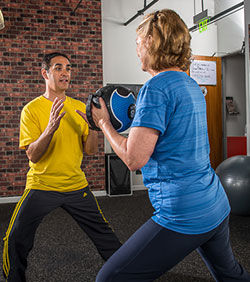
Connecting the dots is really quite simple:
- 1.4 billion people age 20 years or older are overweight, with approximately 500 million of them obese (World Health Organization, 2014).
- Excess body weight is associated with an increased likelihood to develop heart disease, hypertension, type 2 diabetes, gallstones, breathing problems, musculoskeletal disabilities and certain forms of cancer (endometrial, breast and colon) [National Institutes of Health (NIH), 2012]. It is also associated with reduced life expectancy and early mortality [American College of Sports Medicine (ACSM), 2014].
- The only known prevention of obesity involves proper nutrition and regular exercise.
- Health and fitness professionals are uniquely qualified to develop safe and effective exercise programs that can directly impact an individual’s present and future health.

So why is there such a tremendous disconnect between doctors and well-qualified fitness professionals? Many doctors tell their patients, “You should try to lose some weight” or “You might want to start taking short walks a few days a week,” but there is no real guidance and very few people follow through on such vague suggestions. Meanwhile, there are thousands of fitness professionals qualified to help these individuals adopt safe, effective and ongoing fitness programs that will not only change, but very possibly save, their lives. This gap, while seemingly obvious, has proven to be a real chasm in terms of the development of practical, proven means of bringing fitness to those who need it most. Fortunately, there are innovative health and fitness professionals all over the country who are bridging that gap.
According to the International Health, Racquet & Sportsclub Association (IHRSA), approximately 20 percent of the U.S. population is made up of “health club consumers.” Greg Degnan, M.D., medical director of ACAC Fitness & Wellness Centers, home to 38,000 members throughout Pennsylvania and Virginia, points out that, assuming another 20 percent are simply too unhealthy or frail to exercise in that environment, this leaves 60 percent of all Americans as an untapped market. About 16 years ago, Dr. Degnan was challenged by Phil Wendel, founder of the ACAC Fitness & Wellness Centers, to find an innovative means of reaching these individuals.
Armed with the knowledge that fitness is a key part of medicine and that traditional direct-to-consumer marketing is not effective in reaching this audience, Dr. Degnan and his colleagues developed a model based on having a team of sales reps visit doctors’ offices to establish rapport and build a referral base. Dr. Degnan says that sales pitch was essentially, “You prescribe the exercise, and we can be the pharmacy to fill that prescription.”
Continuity of Care
Damon Rouse, M.P.T., O.C.S., founder and director of Asheville Family Fitness, Physical Therapy and Spine Center in Asheville, N.C., started his hybrid physical therapy clinic/fitness center as a way to fill his own exercise prescriptions. After having several former patients return to his office after re-injuring themselves while working out at local fitness facilities or simply unhappy with their options, Rouse developed a business model that allows for true continuity of care and a mission of providing lifelong wellness.
All Asheville Family Fitness members, whether they are former clinic patients or walk-ins looking to work out in a traditional gym, undergo a movement assessment and are placed along a four-level continuum based on the ACE Integrated Fitness Training® (ACE IFT®) Model. The idea, says Rouse, is to “provide members with strategies to start from the right place.” Ongoing education, injury-risk reduction and safe progression are the hallmarks of the facility. The business model, Rouse says, “allows a higher level of supervision and an increased ability to communicate the benefits of exercise as a form of preventive medicine.”
Tricia Strong Thompson, ACE Certified Personal Trainer and Fitness Manager at Asheville Family Fitness, agrees with Rouse that the availability of higher-level knowledge is a tremendous benefit not only to her clients, but also to her own abilities as a personal trainer. “The availability of ‘instant referrals’ is an amazing tool, especially when working with someone who is a former physical therapy patient. Someone tweaks an injury or feels excessive soreness from the previous day’s workout and I can just walk down the hallway to get some expert advice.” From the perspective of a fitness professional, another upside over working in a traditional gym is that Tricia feels that her skill development and education are constantly evolving. Add that to the inherent reward of seeing previously injured clients embrace true, lifelong wellness and you have the recipe for a successful and happy career.
Medical Fitness on a Grand Scale
According to Michael Mantell, Ph.D., Senior Fitness Consultant for Behavioral Sciences at ACE, the “optimal fitness center” of tomorrow will feature fully connected prevention-focused care provided by health-fitness professionals working collaboratively and respectfully of each other’s expertise. This is exactly what is happening at ACAC Fitness & Wellness Centers, as well as at The Summit Medical Fitness Center in Kalispell, Mt.—two facilities that have taken the medical fitness model and expanded it exponentially.
The ACAC Fitness and Wellness Centers have seen 28,000 individuals complete their 60-day Physician Referred Exercise Program® (or P.R.E.P.®), approximately 40 percent of whom have transitioned to a full membership. Dr. Degnan encourages you to stop and think about those numbers for a moment: “These are people who the fitness industry has traditionally been completely unable to reach”—part of that 60 percent he mentioned earlier. “We do this by creating an inexpensive, non-intimidating and safe programming model that emphasizes lifelong wellness.”
Brad Roy, Ph.D., is the executive director of The Summit Medical Fitness Center, a non-profit agency affiliated with Kalispell Regional Medical Center. There is a tremendous amount of crossover between the “medical” and “fitness” components of the facility, with a physician advisory committee made up of individuals representing psychology, cardiology, family medicine, orthopedics and several other specialties providing medical oversight. This creates the ultimate environment of integrated care. Imagine a patient being told she has prediabetes being instantly referred to a fitness professional specializing in weight loss, as well as a registered dietitian and diabetes educator—all in the same building. The benefit for the patient, says Dr. Roy, is that “they receive coaching to help them create a wellness vision. Over time, we address the desired clinical outcomes, but that is secondary at the outset. The key is to facilitate patient engagement in their own healthcare.” In addition, preventing readmission to the hospital is the focus of the entire staff. In other words, the goal is to get patients healthy and then keep them that way.
Positioning Yourself for a Career in Medical Fitness
One of the hallmarks of these facilities is the diversity of their staffs. In addition to its team of physical therapists, Asheville Family Fitness boasts a fitness staff with a wide range of skills and qualifications that includes personal trainers, an aquatics instructor, a health coach, a holistic health coach, a tai chi instructor, a yoga instructor, a massage therapist and an acupuncturist—all working together to provide coordinated care to all members, whether they came through the physical therapy wing or not.

Damon Rouse, Brad Roy and Greg Degnan were each asked about what they look for when hiring fitness professionals. The following is a summary of their advice for breaking into this expanding niche of the fitness industry.
Fitness professionals should gain exposure to the medical and rehabilitation environment by shadowing a physical therapist or serving as an intern, urges Rouse. “This will allow you to differentiate yourself and tap into the market,” he says. In addition, it’s a great way to see first-hand what types of injuries require referral, and to ask questions about what types of referrals are most appropriate in different situations.
A multidisciplinary staff is essential when you’re working with a client base that includes everyone from elite athletes to clients coping with fibromyalgia and other severely limiting conditions, explains Dr. Roy. “Health coaching is key for the medical-fitness population as follow-through and consistency is a real focus.” Most of the fitness staff at The Summit have a bachelor’s level degree or higher, and Dr. Roy requires that all employees have a certification accredited by the National Commission for Certifying Agencies (NCCA). (Note: This includes all ACE certifications.) He also recommends that anyone hoping to work in a medical fitness facility develop a strong background in facilitating behavior change.
Dr. Degnan believes we are entering a “true era of preventive medicine,” where fitness professionals will be optimally positioned to address the obesity epidemic by keeping people from becoming obese in the first place. He goes on to say that new hires must have more than just a basic personal trainer certification and should differentiate themselves through specialized continuing education and advanced certifications. Senior training, pre- and postnatal fitness, nutrition and health coaching are especially pertinent to medical-fitness clients. “Choose something that interests you and sets you apart,” suggests Dr. Degnan, “but most importantly, express a willingness to maintain ongoing education and development.”
The key, says Dr. Mantell, is to be differentiated by way of demonstrated expertise through the ACE Health Coach certification and alignment with lifestyle medicine and medical fitness associations, focused physician groups and other health-oriented facilities. Dr. Mantell recommends you “introduce yourself to local medical practices, bariatric surgery groups, pediatric and geriatric practices, schools and workplaces as an expert in promoting optimal health through lifestyle wellness.”
Conclusion
The hallway that links the physical therapy clinic to the fitness facility at Asheville Family Fitness is the literal manifestation of the metaphorical bridge between medicine and fitness, where you might see a group of high school athletes on their way to a level 4 performance-training session move aside to allow a man in a knee brace to side-step past, an elastic band around his ankles, or an elderly women tandem walk down the hallway while holding onto the railing for support. Better yet, you might see former patients making their way from the medicine side of the bridge to become independent gym members focused on long-term health and exercising as a form of preventive medicine.
References
American College of Sports Medicine (2014). ACSM’s Guidelines for Exercise Testing and Prescription (9th ed.). Philadelphia: Wolters Kluwer/Lippincott Williams & Wilkins.
National Institutes of Health (2012). What Are Overweight and Obesity? http://www.nhlbi.nih.gov/health/dci/Diseases/obe/obe_whatare.html
World Health Organization (2014). Obesity and Overweight. www.who.int/mediacentre/factsheets/fs311/en/





 by
by 




